nalco group
bone, muscle & joint pain physio
BOOK NOW / WHATSAPP ABOUT YOUR PAIN OR INJURY
- NOVENA 10 Sinaran Drive, Novena Medical Center #10-09, Singapore 307506
- TAMPINES 9 Tampines Grande #01-20 Singapore 528735
- SERANGOON 265 Serangoon Central Drive #04-269 Singapore 550265
Home > Blog > Hand Therapy & Customized Splinting > Conditions > Finger, Hand, Wrist, Forearm & Elbow Conditions > Wrist Fracture Hand Physiotherapy
Wrist Fracture Hand Physiotherapy
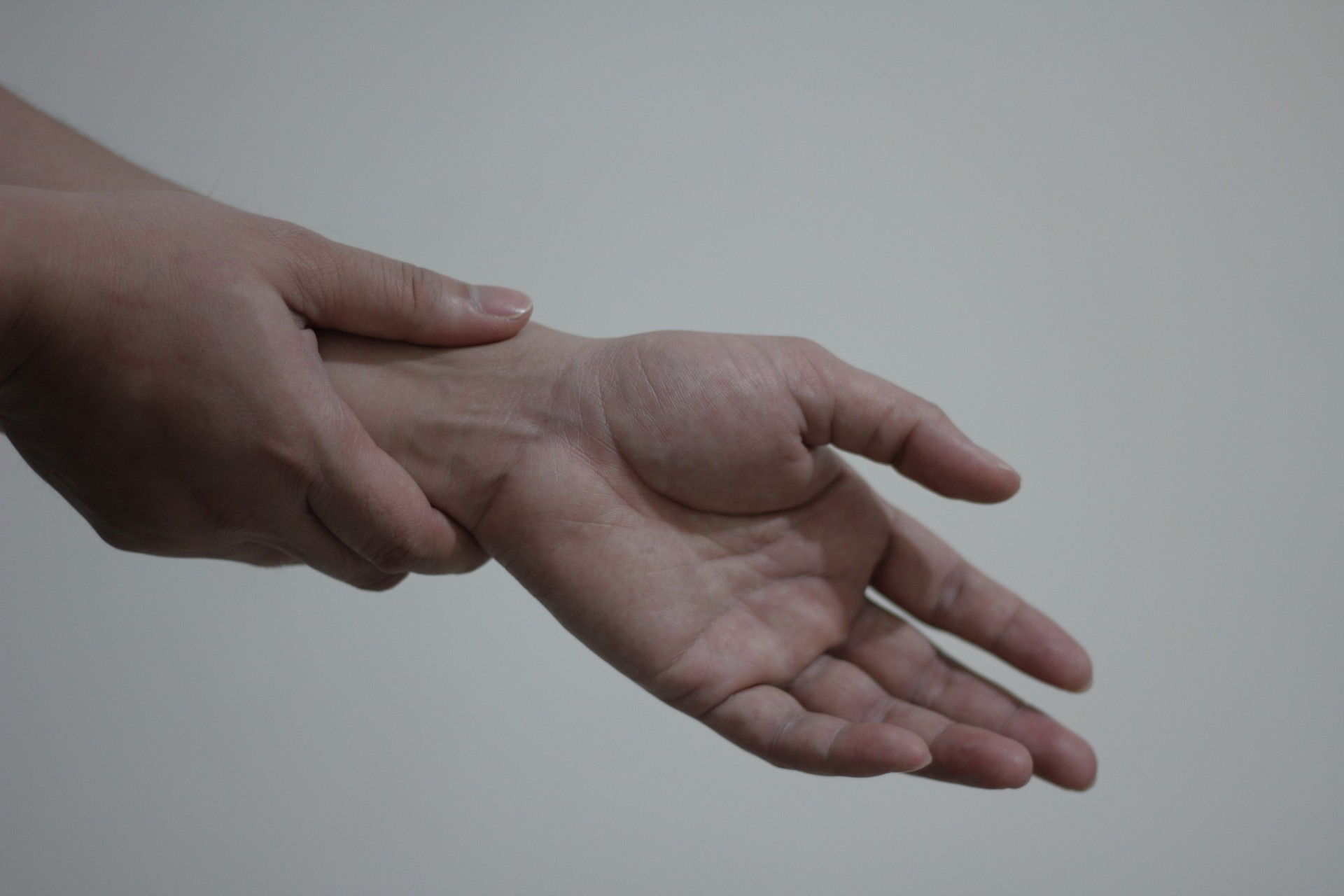
A wrist fracture is a break in one of the bones near the wrist.
In the United States, 1 out of every 10 broken bones diagnosed is a wrist fracture, which highlights the frequency and prevalence of this particularly painful wrist injury. We treat a lot of wrist fracture cases in our physio clinics too.
A wrist fracture can happen as a result of a trauma, such as falling while playing sports or simply tripping when walking down a sidewalk. Children are at higher risks of getting wrist fractures because of the high-risk sports they commonly play.
A child may sustain a wrist fracture
- falling off a bike
- playing football or soccer
- playing tag or catching
- or falling off playground equipment
Wrist fractures are also common in women after menopause, and frequently occur in the elderly population due to falls.
Our senior hand therapists and senior physiotherapists can help individuals who have sustained a wrist fracture
regain normal wrist motion, strength, and function, and learn how to
prevent future fractures.
What Is Wrist Fracture?
A fracture is a crack or a break in a bone.
Wrist fractures due to falls happen most often when people stretch the arm straight out to break their falls as they fall (which unfortunately breaks their wrists).
Our wrist is made up of
- 8 small bones called carpal bones
- 2 bones in the forearm called the radius and the ulna
A wrist fracture is diagnosed when any of those 10 bones breaks or cracks. That being said, most of the time, the most frequently fractured bone is the radius, the bone in the forearm that is closest to the thumb (medically termed as "distal radial fracture")
There are 3 types of bone fractures:
- Type 1 – a "nondisplaced" fracture, where the bone is broken but is still in a normal position.
- Type 2 – a fracture where a fragment of bone is shifted from its normal position.
- Type 3 – the most serious type of fracture, with multiple breaks of the bone or bones.
Type 1 and 2 fractures usually are treated without surgery. Type 3 fractures, however, usually will require corrective wrist surgery.
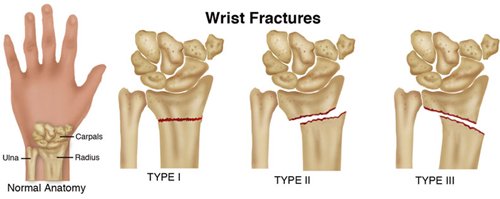
How Does a wrist fracture Feel like?
A fractured wrist is usually painful and movement is affected. If you have sustained a wrist fracture, you may experience:
- Pain in the area of the fracture, which could be anywhere in the wrist, depending on which bone was affected. The pain can radiate (travel) from the wrist into the fingers, and even into the forearm
- Swelling in the wrist and possibly in the hand, usually on the top surface of the wrist and hand
- Stiffness in the wrist and fingers
- Tenderness to touch in the wrist
- Difficulty and pain when moving the wrist or fingers
How Is It Diagnosed?
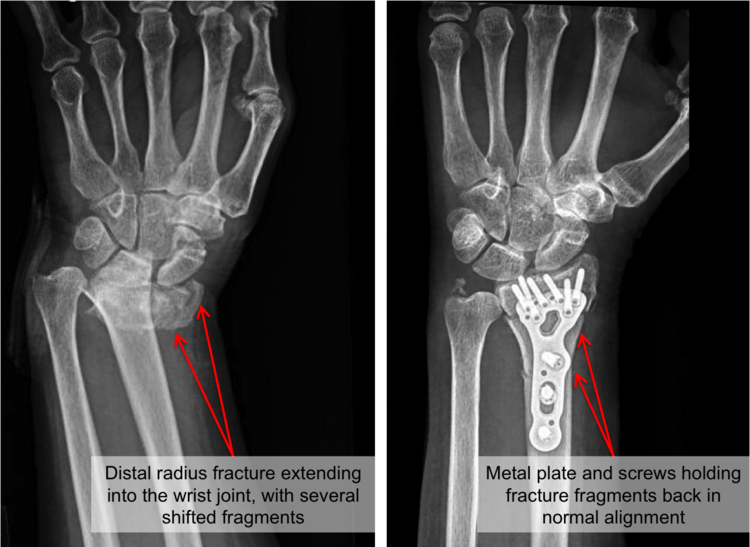
An x-ray is the best and clearest method to diagnose a wrist fracture.
If you have sustained a fall and are experiencing any of the symptoms mentioned above, you need to visit an emergency room, an urgent-care center, or our medical network of doctors directly to get a complete diagnostic x-ray.
If we suspect that you have a wrist fracture, we may arrange for an x-ray and refer you to an appropriate physician. We can check for damage to other joints and muscles, and make sure that the nerves and blood vessels in your wrist, forearm, and hand have not been affected by the broken bone.
In most cases, patients with new wrist fractures visit an orthopedic surgeon with a specialty in managing bones and joints (also known as an orthopedist).
Depending on the type of fracture, the doctor might prescribe a cast or a sling to immobilize the area for a period of time until the fracture is healed or recommend ORIF surgery to stabilize the wrist fracture.
The amount of healing time varies, depending on the individual and the type of fracture, and can take anything from 6 to 12 weeks. Of course, the recovery time may be longer following hand and wrist corrective surgery, depending on the severity of the injury.
how our senior hand therapists and senior physiotherapists can help you
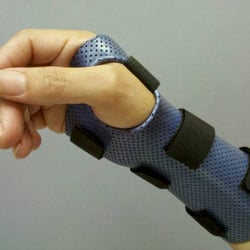
We will work with you following a wrist fracture to help you regain normal wrist motion, strength, and function, and will provide education and training to help you prevent future fractures.
While Your Wrist Is In a Cast or a Sling
While your bone heals, your arm will be in a cast or a sling to keep it still and promote healing. During that time, it is important to ensure that the arm and uninjured joints does not get too
- stiff
- weak
- or swollen
Depending on the amount of activity that is allowed for your type of fracture, we will prescribe gentle exercises to keep your shoulder, elbow, and fingers moving while you are in the cast or sling.
Most people with wrist fractures will slowly return to exercising the other arm and the legs, so that the rest of the body doesn't get out of shape while the fracture is healing.
We can help you adapt your exercise program, so that you can maintain your overall strength and fitness without interfering with the healing of your wrist.
When the Cast or Sling Is Removed
After your cast or sling is removed, your wrist will most likely be stiff, and your arm will feel weak. We will examine your wrist, and select treatments to improve its function and restore strength to your arm.
Your wrist fracture hand therapy will include treatments to:
Reduce Pain
We might use the following treatment modalities such as
- cold therapy
- heat therapy
- ultrasound therapy
- radio-frequency Indiba physiotherapy
- electrical stimulation
- etc
to help control pain or swelling in your wrist, hand, or arm.
Relieve Stiffness
We may use skilled hands-on techniques (manual therapy) such as
to enable your joints and muscles to move more freely with less pain.
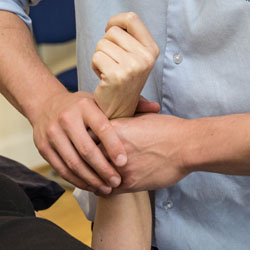
Increase Your Strength and Ability to Move
We prescribe several types of exercises during recovery from a wrist fracture.
Early on, we can help you begin to gently move your elbow, using "passive range-of-motion" exercises. As your arm gets stronger, you can exercise it yourself without weights ("active range-of-motion" exercises).
Once the bone is well-healed, you can begin to perform resistance exercises, using weights or elastic bands. In addition to prescribing range-of-motion and strengthening exercises, we can help you retrain your muscles to react quickly when you need to protect yourself from a fall.
Get Back to Your Daily Activities
We will help you remain independent by teaching you how to perform your daily activities (eg, dressing, working on a computer, and cooking), even while wearing a cast or a sling.
Once you can move your arm freely without pain, we may begin adding activities that you were doing before your injury, such as using your arm for dressing, grooming, and housekeeping.
We will design your individualized program based on an examination of your wrist, goals, level of physical activity, and general health.
Prepare for More Demanding Activities
Depending on the requirements of your job or the type of sports you play, you might need additional hand physical therapy tailored to meet specific demands. We will develop a specialized program to address your unique needs and goals.
Prevent Long-Term Disability
Everything we prescribe for you will help prevent long-term disability by:
- Returning the arm to a strong level of fitness.
- Restoring full movement and strength in a safe manner, while healing occurs.
- Assessing the fracture to make sure that you can return safely to previous home and work activities.
- Guiding you to a safe return to sports and other physical activities. A return too early after a fracture may increase the risk of another fracture.
- Recommending protective equipment, such as wrist guards, for use during sports.
